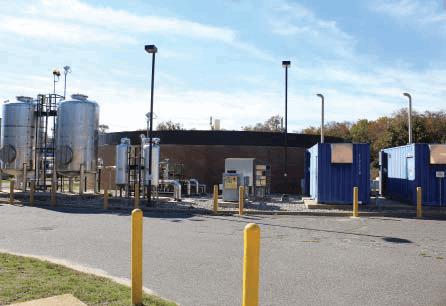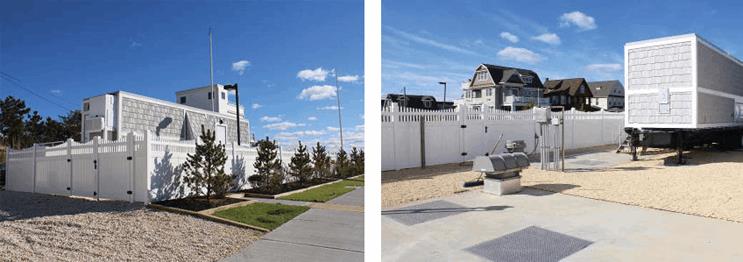A Small Utility's Path To Climate Change Readiness
By Rina N. Dalal
From the lessons of Superstorm Sandy, a road map to resiliency for small, at-risk utilities emerges.
How does a small coastal utility deal with recurrent service outages and the expense of repeatedly rehabilitating storm-damaged infrastructure? The South Monmouth Regional Sewerage Authority (SMRSA) has developed a program that serves as a model for other utilities seeking to reduce the impacts of climate challenges.
SMRSA serves 60,000 people across eight coastal New Jersey communities including Belmar, Brielle, Lake Como, Manasquan, Spring Lake, Spring Lake Heights, Sea Girt, and a portion of Wall Township. Founded in 1970, SMRSA’s sewerage collectio n and conveyance system consists of a 9.1 MGD wastewater treatment plant, 11 pumping stations, and 11.8 miles (18.9 km) of force main. Treated wastewater effluent is conveyed to the Atlantic Ocean.
The extreme wet weather events that plague the region bring flooding and storm surges to SMRSA’s sewer service area. Superstorm Sandy, which was one of the worst storms to impact the area, rendered 10 out of 11 pump stations inoperable and cost the authority $10.5 million in damages. Two shoreline pump stations received severe structural damage when a 13-foot storm surge brought 7 feet of saltwater and several tons of sand onto the pump station sites. The authority found itself in a cyclical pattern of destruction followed by rehabilitation of its critical infrastructure in the aftermath of severe storms. In some cases, the authority would spend hundreds of thousands of dollars to replace an asset after a storm, only to have it destroyed shortly thereafter. SMRSA recognized that it was necessary to include climate challenges in long-term planning goals.
To meet these objectives, SMRSA has begun to execute a Climate Change Readiness Program for its sewer service area. The goal of the program is to incorporate greater resiliency into the authority’s infrastructure so that it is prepared for the impacts of a rising sea level, storm surges, and frequent and intense rain events. In addition, the authority seeks to reduce greenhouse gas emissions from its facilities and achieve independence from utility power so that they may provide uninterrupted service during a power outage.
First Mitigate
The U.S. EPA defines climate change mitigation as “human intervention to reduce the human impact of the climate system.” Mitigation strategies include reducing greenhouse gas sources and emissions, which contribute to climate change. To mitigate effectively and meet its greenhouse gas reduction goals, SMRSA identified energy conservation and renewable energy generation opportunities within its facilities. A utility-wide energy audit was conducted to determine the authority’s energy usage. The audit revealed that in addition to some low-hanging fruit options for energy conservation within the treatment plant, the implementation of a cogeneration system would yield the most energy conservation and greenhouse gas emission reduction benefits.
In 2010, the authority constructed a combined heat and power (CHP) cogeneration facility. The cogeneration system is a renewable energy generation system where greenhouse gas emission reduction is achieved. Methane gas produced by the anaerobic digestion of the plant’s residual sludge is utilized to fuel two on-site internal combustion engines that generate approximately 50 percent of the wastewater treatment plant’s electrical energy and nearly 100 percent of the thermal energy required to operate the facility.

SMRSA cogeneration system
Utilizing this energy reduces the use of utility power and has displaced the emission of approximately 1,035 metric tons of CO2 during 2015. This is the environmental equivalent of 150 houses off the electrical grid. The cogeneration system not only allowed SMRSA to reduce dependency on grid-based power, but it significantly curbed methane gas release into the atmosphere. On average, SMRSA is currently utilizing 99 percent of the digester gas produced by the treatment plant to fuel two on-site internal combustion engines. Approximately 1 percent is lost to the atmosphere through its flare as methane, as opposed to 70 percent prior to the installation of the cogeneration system. The implementation of the CHP program has had a fiveyear payback on its initial investment. “The resultant savings that are realized every year thereafter are being utilized as a revenue stream to fund additional climate change related incentives,” says Michael Ruppel, executive director of SMRSA.
During Superstorm Sandy, the treatment facility lost power supply for 14 consecutive days. During a power outage, SMSRA’s cogeneration system must be shut down for the safety of the utility personnel repairing other portions of the power grid. Therefore, the authority was forced to rely on its diesel-fired standby auxiliary power systems to run the plant. While this allowed for reliable service from the treatment plant, access to diesel fuel was limited as other utilities in the region faced similar challenges. The lesson learned from the Sandy experience was that if the authority could increase the electrical and thermal energy production of the existing cogeneration system, it could provide continuous treatment capability during similar storms without relying on grid-based power or diesel fuel systems.
To meet the full electrical demand of the treatment plant, the authority plans to install a third engine to expand the existing cogeneration system. A new dual-fuel 315 kW internal combustion engine and generator, operating on both natural gas and methane gas, will be installed. The two existing 140 kW internal combustion natural gas engines will be upgraded to 160 kW duel fuel engines (natural gas and biogas) and be operational only when there is a power outage or during periods when the 315 kW internal combustion engine is offline for maintenance or repair. During a power outage, the 160 kW internal combustion engines will be operated on natural gas only. The available methane gas that is generated by the treatment plant will fuel the 315 kW internal combustion engine. When methane gas is no longer generated by the treatment plant, natural gas will be used to fuel this engine. The combined operation of the three engines will supply enough power to operate the treatment plant, thus allowing the CHP system to operate in “island” mode, with zero reliance on a grid-based power system. Construction of the cogeneration system is anticipated to be completed in 2018.
Adapting To Climate Change
While mitigation strategies address one of the underlying causes of climate change, adaptation plans seek to prepare for and adjust to climate change challenges.
SMRSA’s pump stations are particularly vulnerable to the impacts of sea level rise and storm surge during wet weather events because of their low-lying and, in some cases, shoreline locations. To address this vulnerability, SMRSA has implemented the unique concept of a mobile enclosure that houses critical electrical equipment and can be removed from the pump station to a safe inland location in the event of a storm-related emergency. The mobile enclosure closely resembles a mobile home trailer and can be mobilized within an hour’s notice.
Diesel-powered portable pumps and/or a sacrificial generator render the pump station fully operational during a storm. Once the storm subsides, the enclosure can be moved back to the station and all electrical equipment is put back online. Electrical and control connections between the enclosure and the pump station and its equipment are made with cables and plugs that are opened to allow removal of the enclosure. An expendable portable generator and transfer switch will be transported to the site to operate the station if utility power is lost. Ryan Krause, authority engineer, noted, “This capability will minimize any damage to the station’s electrical equipment and significantly reduce downtime of the station.” The station is capable of returning to normal operation within hours after a storm, whereas with a conventional station, if the electrical and control equipment were to be damaged, the station could be out of service for weeks until the equipment is replaced, causing significant environmental damage.

Belmar pump station mobile enclosure
The first mobile enclosure was constructed at a pump station in Sea Girt, N.J. in 2011. When Superstorm Sandy swept through the region, this pump station was the only one that was operational within SMRSA’s system. SMRSA sought the same level of protection at its other pump stations but understood that resiliency could not be a one-size-fitsall approach. Ruppel stated “We recognized that without an understanding of the scale, location, and timing of the climate change challenges that could occur, we were at a loss when adopting effective resilience strategies for the pump station.” Prior experience told them that each station was uniquely impacted by weather events.
As a result, SMRSA partnered with the EPA to undertake a pilot study of EPA’s Climate Resilience Evaluation and Awareness Tool Version 2.0 (CREAT 2.0). By providing historical and projected climate data, this computer software tool assisted SMRSA in understanding potential climate change-related risk to the pump station infrastructure. Due to the fact that the tool provides data from multiple climate scenarios, SMRSA can understand their risk across multiple possible future climate conditions: “hot and dry” or “warm and wet.” The tool also enabled SMRSA to understand how the implementation of resiliency measures, such as the mobile enclosure, may reduce the risk to those threats. SMRSA has undertaken an ongoing effort to utilize CREAT to select the most resilient and cost-effective adaptation measures for the 11 pumping stations. This allows the user to navigate their way through the uncertainty surrounding climate change and plan for the best- and worst-case scenarios.
The mobile enclosure design has been replicated twice within SMRSA’s service area in the town of Lake Como and the Borough of Belmar. Due to its renowned success, the project has been heralded by the Federal Emergency Management Agency (FEMA) and the EPA as a Best Management Practice for mitigation of damages related to extreme wet weather events. The scalability of the design concept gives it the potential to be implemented by other critical utility service providers that face similar challenges.
Planning for climate change challenges brings complex issues for water and wastewater utilities which must balance reliability, cost constraints, and the uncertainty of what future climate challenges may bring. By embracing cutting-edge solutions and proactive planning strategies, South Monmouth Regional Sewerage Authority stands at the forefront of the industry as being one of the first climate-ready utilities.
About The Author
 Rina N. Dalal is a senior staff designer at T&M Associates headquartered in Middletown, NJ, a full-service environmental engineering consulting firm. She works in the Water Resources Practice where she contributes to climate change resiliency and water and wastewater infrastructure improvement projects. She holds a bachelor’s degree in Environmental Engineering and a master’s degree in Sustainable Design.
Rina N. Dalal is a senior staff designer at T&M Associates headquartered in Middletown, NJ, a full-service environmental engineering consulting firm. She works in the Water Resources Practice where she contributes to climate change resiliency and water and wastewater infrastructure improvement projects. She holds a bachelor’s degree in Environmental Engineering and a master’s degree in Sustainable Design.
